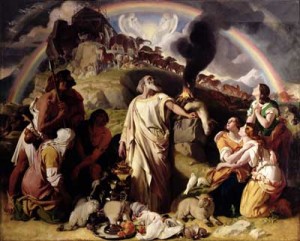Jul
31
The Women on the Ark (Part 2 of 2): How Old Were They, Anyway?
In my last post (Part 1), I mentioned the genetic evidence pointing to a “mitochondrial Eve” and “Y-chromosomal Adam” in humanity’s origin. I then discussed the idea that the RTB Creation Model may be a little too restrictive in its dependence on three distinct maternal lineages via Noah’s daughters-in-law. Today, though, I’d like to make a somewhat-related observation of the text and ask another question: Did the women on the ark — or, any women of that era — live as long as the men did?
The Biblical text doesn’t tell us the names or ages of these women. Again, we might reasonably assume that they were roughly the same ages as their respective spouses — i.e., Noah at 600 and Shem/Ham/Japheth <=100, at the time of the Flood. (Shem was eldest at either 98 or 100*.) Then again, no women are listed among those with excessive lifespans, either pre- or post-Flood. There could be a number of reasons for this. For example, 1) the ancients were a patriarchal society; or, 2) the significance of the genealogies was primarily to show the male bloodline to Abraham; or, 3) women didn’t live nearly as long. Or, maybe all three and/or something else. We just don’t know.
We usually think of Eve being about the same age as Adam (especially if within a “24-hour Day” interpretation for Gen. 1), but we don’t really know how long Adam lived & worked in the Garden before Eve was formed. We don’t know how old Eve (or Adam) was when either Cain or Abel was born. (Nor do we know how old any of them were when Cain killed Abel. We know the “boys” were old enough to till the ground and tend flocks, respectively; but, one or both may have been teenagers, or they both may have been over 100, or anywhere in between.) Nor does the Bible tell us how old Eve was when she gave birth to Seth, though it does say that Adam was 130. Of course, this may all be somewhat moot, since Eve (like Adam) was probably created sexually mature from the beginning.
We also know from other scriptural passages that a) the pre-Flood men were able to have children at least as early as 65 years (e.g., Mahalalel & Enoch), though we don’t know about the women’s child-bearing years; and, b) at least from Abrahamic times forward, men often took wives who were much younger than they were, and it wouldn’t be at all surprising if this was true going back (almost) to the beginning. So, regarding ages of the women on the Ark, we can only speculate about Noah’s daughters-in-law. All we can say for (almost) sure is that Noah’s wife was at least a few years over 100 at the time of the Flood — i.e., because her oldest son was in the 100-year range + adding at least 15 or 20 years before she could have children. Back then, though, sexual maturation may have taken a bit longer.
Even this estimate for Noah’s wife’s age makes two important assumptions: 1) Shem was her biological child. It would have been irrelevant to the Flood account, but it is possible that Noah had a previous wife. If so, his peridiluvian** wife could have been older or younger, since her age would then be independent of Shem’s age. 2) Shem was her very first child. If, as postulated in Part 1, she had children before Shem, then she could have been older than the 115 or so estimated above at the time of the Flood.
So, whaddayathink? Am I “all wet”, here? Note that I’m not making any hard claims — just sort of feeling out the boundaries, if you will. Am I an idiot for spending any time on this? Does anyone else think this is interesting?
* Gen. 9:24 refers to Ham as Noah’s youngest. Gen. 10:21 says Shem was older than Japheth. Gen. 11:10 seems to indicate that Shem was 100 when he fathered Arpachshad, two years after the Flood, meaning he was 98 at the time of the Flood.
** “Peri-diluvian”. Yeah, I made that up. But, the wife mentioned in Scripture was there pre-flood (aka antediluvian), during the flood, and post-flood (aka postdiluvian). I wanted a term that meant “around the time of the flood” and “diluvian” by itself didn’t quite fit. So, I added the “peri” prefix, similar to perimortem, which means “around the time of death”.
















